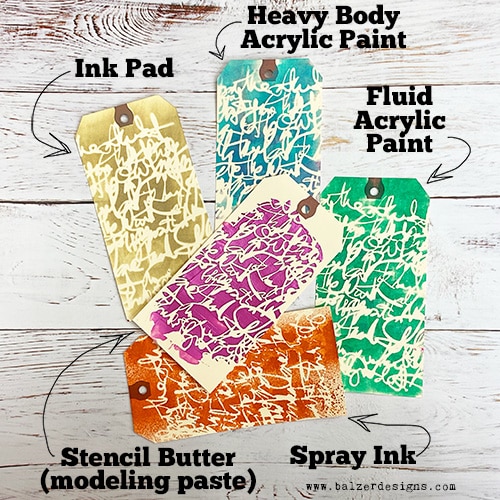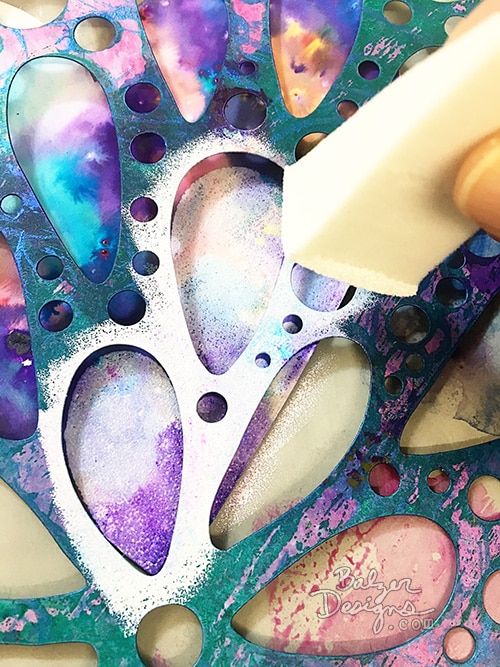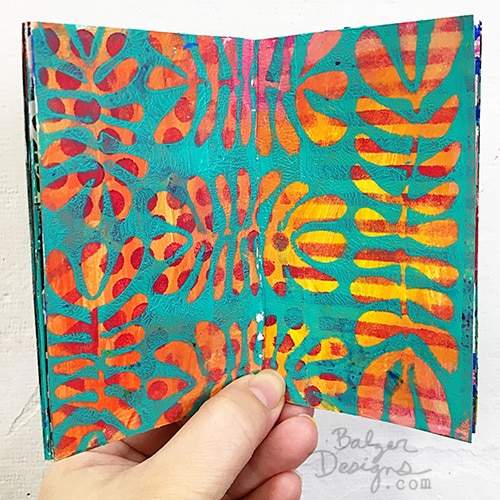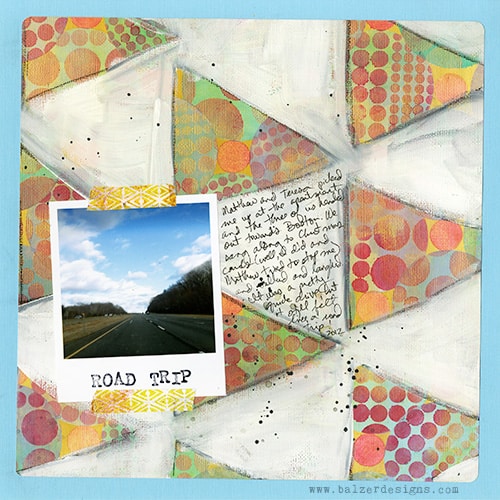Wondering how to stencil? Let’s start with what kind of stenciling you want.
Do you like nice neat precise stenciling? Or are you more of a messy stenciling fan?
Getting the look you want is all about understanding how the medium you’re using needs to be handled. The wetter the medium, the more likely you’re going to get roll under. But you can take some careful steps to avoid roll under with all mediums. And that’s what this video is all about:
Here are links to the mediums I used in the video:
- A Distress Ink Pad
- TCW Stencil Butter (modeling paste-ish)
- Heavy Body Acrylic Paint
- Fluid Acrylic Paint
- Distress Stain Spray Ink
Stenciling Basics and Mediums
It’s important to understand what kind of stencil or mask you’re working with and how different mediums will behave with it. The example used in the video (“Messy Writing” 6×6) is technically a mask, not a stencil, because it is a single piece without a border and blocks the background. Keep in mind that each medium produces its own look, from crisp and clean to loose and organic.

Mediums in Order from Neatest to Messiest:
- Ink pads with blending tool – driest, least roll-under.
- Modeling/stencil paste – thick, minimal roll-under.
- Heavy-bodied acrylic paint – more texture, small roll-under.
- Fluid acrylic paint – wetter, more roll-under risk.
- Spray inks & watercolor – wettest, most roll-under.
Stencil Application Techniques
The method you use to apply your medium has a huge impact on the final result. From tapping with a sponge…

…to scraping with a palette knife, each approach affects the amount of detail, texture, and roll-under that you get.
- Dry mediums = cleaner lines, wet mediums = more roll-under (paint bleeding under stencil).
- Ink blending tool – Tap and rub gently; clean and crisp results.
- Stencil butter with palette knife – Apply in one pass to reduce roll-under; thicker = cleaner.
- Heavy-bodied paint with sponge – Tap up and down, avoid excess paint; less moisture = cleaner.
- Fluid acrylic paint – Same tapping method but more roll-under due to higher moisture content.
- Spray ink – Most roll-under; can produce unpredictable, looser effects.
Tips for Cleaner Stenciling
A few practical habits can help you control roll-under. These tips are especially useful if you prefer crisp, defined stencil patterns.

I like both messy and clean, but clean can be more difficult to achieve for beginners. Here are some tips:
- Always tap off excess paint or ink before applying to stencil.
- Wet = enemy of clean stenciling; dry materials yield sharper results.
- Hold the stencil firmly — use tape or spray adhesive if you want zero shifting.
- Multiple passes increases the chance of roll-under.
- If you like imperfect or layered effects, lean into wetter media.
Cleaning Stencils and Creative Reuse
Cleaning your stencil is optional — in fact, leaving it dirty can spark unexpected creative results. You can use leftover paint or ink for bonus prints rather than washing it away.
- Cleaning is optional – I prefer making over cleaning.
- Quick clean: baby wipe or flip stencil to transfer leftover medium onto another surface.
- Dirty stencils can produce interesting bonus prints when pressed onto paper.
- Leaving your stencil uncleaned can create surprises in future projects.

Final Thoughts on How To Stencil To Get What You Want
At the heart of stenciling is personal preference. Whether you want perfection or happy accidents, the best results come from knowing your style and embracing it.

- Know your style – perfection vs. embracing imperfection.
- No technique is “right” or “wrong” — it’s about the look you prefer.
- Use leftover paint/ink creatively rather than wasting it.
What’s your favorite medium to use with stencils? Or even a medium you think can’t be used with stencils?! I’d love to know.
Thanks for stopping by!
PS: Be sure to check out all of my other blog posts about stenciling and mixed media!

I prefer neat and precise stenciling, but rarely achieve it, using acrylic paint & a makeup sponge. I don’t think I’ve ever tried using an ink pad – so this was very helpful!! Since I don’t have an ink blending tool, I’ll try ink + a makeup sponge and if it’s not nice and crisp, I’ll spring for the blending tool. Thanks Julie!
no surprise here – I like messy. but, sometimes neat and clean is just the thing. I guess I’m a bit fickle. LOL
Great demo! I mostly use inkpads or acrylics with my stencils. I’ve haven’t mastered the spray inks before but thanks to your demo I did!
Can I buy this in the UK PLEASE
If you visit The Crafters Workshop website youll see shops in the UK that stock their stencils.